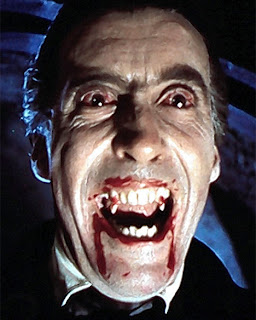DRACULA (1958)
Phil Leakey’s make-up for Hammer's ground-breaking THE CURSE OF FRANKENSTEIN. The last-minute design was a collage of mortician’s wax, rubber, and cotton wool.
WITH their lurid, uncompromising tone, and relentlessly amoral protagonists, Hammer’s legacy as the most successful horror film production company is testament to the quality of the personnel involved. Released onto a market dominated by science fiction creature features, THE CURSE OF FRANKENSTEIN was Hammer’s breakthrough picture; directors such as William Castle and Roger Corman in the United States, and Riccardo Freda and Mario Bava in Italy, were soon following Hammer’s grand guignol lead. Helmed by Terence Fisher, the film is a flamboyantly visceral retelling of Mary Shelley's classic, casting Peter Cushing as Baron Von Frankenstein, and Christopher Lee as his reanimated creation.
THE CURSE OF FRANKENSTEIN established Fisher’s ability to lend credible characterisation to formula-bound material. The John Ford of English Gothic cinema, Fisher's work presents a fascinating moral dilemma: the seductive appeal of evil, versus the close-minded representatives of good. The consistency of theme in Fisher's work, coupled with a distinctive style achieved through precise framing and dynamic editing, refutes the idea that he was merely a hack for hire. In the best of his work, there is an element of spirituality that remains unique in a genre supposedly larger-than-life; Fisher’s characters die less often from violence, than from their adherence to a belief. His five Frankenstein films for Hammer can be taken as a single work, a path that follows the metamorphosis of physician into metaphysician into quack, as the Baron’s preoccupations blind him to the importance of human life and, finally, his own mental health. In the last entry of the cycle, FRANKENSTEIN AND THE MONSTER FROM HELL, a final judgement on the Baron seems that the asylum setting of the film is the best place for him.
Fisher’s achievement is complemented by Jack Asher’s lavish Eastmancolor photography, the gothic opulence of Bernard Robinson’s production design, and James Bernard’s ominous score. Furthermore, Jimmy Sangster’s literate script sees the Baron misguidedly sincere rather than intrinsically evil; not the madman of popular myth, but a scientist challenging God as a triumph of Man’s intellect. In addition to this already bulging bag of riches, you have the casting of Cushing and Lee. Both actors’ consistently elegant performances would do much to elevate the British horror film to a position where it commanded international attention. Cushing was a master of eloquence and physicality, combining impeccable diction with a manic athleticism. Lee’s Creature, as Fisher once recalled, a "wandering, forlorn minstrel of monstrosity," fuses a colossal physical presence with an icy allure. The Creature wears a shabby military greatcoat - the very image of society’s dispossessed rejects - and its futile, puppet-like attempts at communication are followed by the inevitable, exasperated lapses into violence. The monster’s introduction, bandaged, and framed in a laboratory doorway, supplemented by an unearthly tracking shot, is a scene that determined Hammer Horror.
Reconvening the major talents from THE CURSE OF FRANKENSTEIN, DRACULA is a maturing of style against the blueprint of its predecessor. Seminal in the character's film canon – the Count’s first colour adaptation – Terence Fisher’s film is, however, a free and melodramatic re-evaluation of Bram Stoker’s 1897 novel. Jonathan Harker (John Van Eyssen) is now a dedicated vampire hunter working under the tutelage of Van Helsing (Peter Cushing), who, in turn, is no longer the priest-physician-teacher of the novel, or the elderly savant typified by Edward Van Sloan in Universal’s 1931 film, but younger and more dynamic. Yet the film is far truer in tone to the original text; The Count (Christopher Lee) represents liberation at its most overt, shifting the characters cinematic emphasis from the supernatural to the sexual. Initially presenting its female leads as submissive, stereotypical Victorian women, both Lucy (Carole Marsh) and Mina (Melissa Stribling) transform when they encounter their demon lover, breathless in anticipation, and eager for brutish, physical contact.
Reconvening the major talents from THE CURSE OF FRANKENSTEIN, DRACULA is a maturing of style against the blueprint of its predecessor. Seminal in the character's film canon – the Count’s first colour adaptation – Terence Fisher’s film is, however, a free and melodramatic re-evaluation of Bram Stoker’s 1897 novel. Jonathan Harker (John Van Eyssen) is now a dedicated vampire hunter working under the tutelage of Van Helsing (Peter Cushing), who, in turn, is no longer the priest-physician-teacher of the novel, or the elderly savant typified by Edward Van Sloan in Universal’s 1931 film, but younger and more dynamic. Yet the film is far truer in tone to the original text; The Count (Christopher Lee) represents liberation at its most overt, shifting the characters cinematic emphasis from the supernatural to the sexual. Initially presenting its female leads as submissive, stereotypical Victorian women, both Lucy (Carole Marsh) and Mina (Melissa Stribling) transform when they encounter their demon lover, breathless in anticipation, and eager for brutish, physical contact.
Valerie Gaunt, thirsting for blood, in DRACULA.
Cushing is impeccable, radiating an Old World charm and a confidence in his rightness, but this is Lee's movie. Instead of the stylised movement, hypnotic stare and thick accent of Bela Lugosi, Lee is more physically imposing than any other actor in the role, and intractably feral. Make no mistake, Lee's Dracula is Stoker's Dracula, a charming, well-spoken, imperious aristocrat, overwhelming his female victims with sheer animal magnetism. Biting his victims discreetly by modern standards, but explicit to audiences who might have expected this activity to be shielded by the judicious swirl of his cape, Lee’s Count is a flesh-and-blood monster to be grappled with at close quarters, rather than some ethereal, blood-drinking ghost in formal wear. Van Helsing and Dracula represent a myriad of Fisheresque dualities; good and evil certainly, but also order and chaos, civilisation and anarchy, the soul of humanity and the spirit of the beast.



